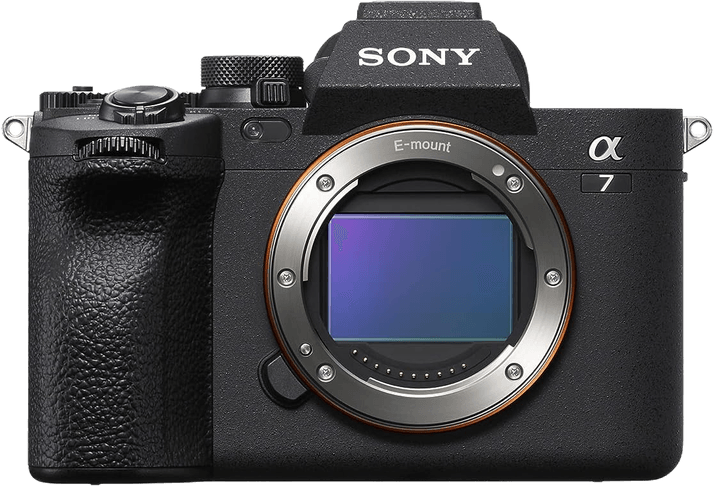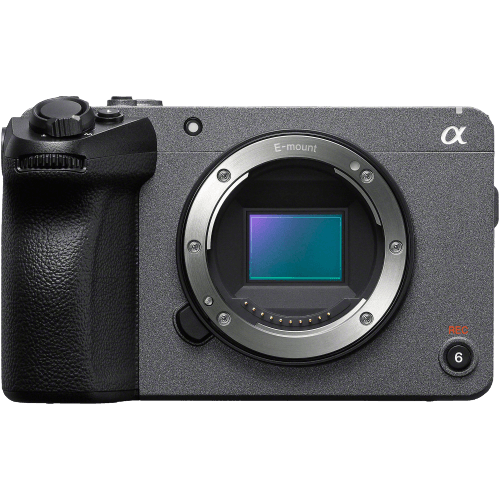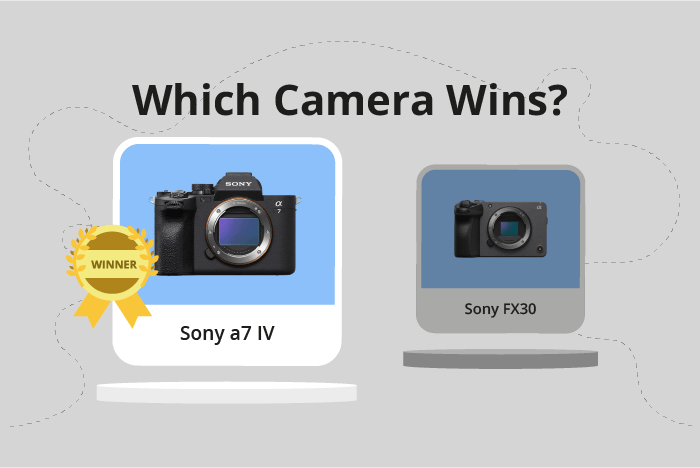Sony a7 IV vs FX30 Comparison
Sony a7 IV

Sony FX30

The Sony a7 IV outperforms the Sony FX30 by a margin of 4 points, scoring 84/100 compared to the FX30’s 80/100. Both cameras are mirrorless, with the a7 IV being released in 2021 and the FX30 in 2022. They share similar dimensions, with the a7 IV measuring 131 x 96 x 80mm and weighing 659g, while the FX30 measures 78 x 130 x 85mm and weighs 646g.
The Sony a7 IV’s higher score reflects its better performance, justifying its higher launch price of $2499 compared to the FX30’s $1799. However, the Sony FX30 has its advantages too, being slightly lighter and more compact, which may appeal to some users.
Taking these factors into account, the Sony a7 IV stands out as the superior camera, but the Sony FX30 may still be a suitable option for those seeking a more affordable and portable choice.
Sony a7 IV vs FX30 Overview and Optics
The Sony a7 IV emerges as the winner in optics with a score of 85/100, outperforming the Sony FX30’s score of 78/100 by 7 points. Both cameras share several specifications, such as a CMOS sensor, Bionz XR processor, shooting speed of 10 frames per second, and image stabilization. However, there are differences that set the Sony a7 IV apart and contribute to its higher score.
The Sony a7 IV boasts a higher megapixel count of 33, compared to the FX30’s 26 megapixels. This difference allows the a7 IV to capture more detail and produce higher resolution images. Additionally, the a7 IV has a superior DXOMARK sensor score of 97, compared to the FX30’s score of 94. This higher score means the a7 IV’s sensor delivers better image quality in terms of dynamic range, color depth, and low-light performance.
Another advantage of the a7 IV is its full-frame sensor size, compared to the FX30’s APS-C sensor. The larger sensor size provides better low-light performance, increased dynamic range, and shallower depth of field. Furthermore, the a7 IV uses the Sony FE lens mount, which supports a wider range of high-quality lenses, compared to the FX30’s Sony E mount.
The Sony FX30, however, does not have any significant advantages over the a7 IV in terms of optics. Both cameras share the same shooting speed and image stabilization features, but the FX30 falls short in other areas.
Considering the differences in megapixel count, sensor scores, sensor size, and lens mount compatibility, the Sony a7 IV is the superior camera for optics. The FX30 may be a decent option for some users, but it does not offer any advantages over the a7 IV in this regard.
Sony a7 IV vs FX30 Video Performance
The Sony a7 IV outperforms the Sony FX30 in video capabilities, with a score of 91/100 compared to the FX30’s 77/100. Both cameras offer 4K resolution, with maximum video dimensions of 3840 x 2160 and a maximum frame rate of 120fps. However, there are differences that make the a7 IV the superior option.
The a7 IV has a built-in time-lapse functionality, which the FX30 lacks. This feature allows users to create stunning time-lapse videos without needing additional equipment or software. This advantage is significant for videographers who require time-lapse capabilities for their projects.
On the other hand, the Sony FX30 has its merits as well. Although it does not excel in video capabilities compared to the a7 IV, it still provides 4K resolution and a high frame rate of 120fps. These features are essential for producing high-quality videos, and the FX30 can still deliver in this aspect.
Considering the points discussed, the Sony a7 IV is the clear winner in terms of video capabilities, mostly due to its built-in time-lapse functionality. The Sony FX30, while not as strong in this area, remains a viable option for those who prioritize 4K resolution and high frame rates but do not require time-lapse features. Ultimately, the choice between these two cameras will depend on the specific needs of the user and their video projects.
Sony a7 IV vs FX30 Features and Benefits
The Sony FX30 wins the feature comparison with a score of 85/100, while the Sony a7 IV scores 83/100. Both cameras share several specifications, including a 3-inch screen size, touchscreen capabilities, flip screens, and the absence of GPS. They also both have WIFI and Bluetooth connectivity.
The Sony FX30 outperforms the Sony a7 IV in screen resolution, offering 2,360,000 dots compared to the a7 IV’s 1,040,000 dots. This higher resolution provides a clearer and more detailed display, making it easier for users to review images and navigate menus.
The Sony a7 IV, despite its slightly lower score, still has some advantages over the Sony FX30. However, these advantages are not found in the specifications provided. Further research and analysis would be required to determine if there are any areas in which the a7 IV surpasses the FX30.
In terms of features, the Sony FX30 is the superior camera due to its higher screen resolution. This advantage enhances the user experience by providing a crisper display for reviewing images and navigating menus. The shared specifications between the two cameras, such as screen size, touchscreen capabilities, flip screens, WIFI, and Bluetooth connectivity, make them comparable in many aspects. However, the Sony FX30’s higher feature score indicates that it is the better camera in this comparison.
Sony a7 IV vs FX30 Storage and Battery
The Sony a7 IV and Sony FX30 both score 76/100 in storage and battery, showing no difference in overall performance. Both cameras have two memory card slots and accept CFexpress Type A and SD (UHS-II compatible) cards. They also share the same battery type, the NP-FZ100, and support USB charging.
The a7 IV edges out the FX30 with a slightly better battery life, providing 580 shots compared to the FX30’s 570 shots. This advantage may be beneficial for photographers who require longer shooting sessions without changing batteries.
On the other hand, there is no area where the FX30 outperforms the a7 IV in terms of storage and battery. The only difference between the two cameras is the 10-shot difference in battery life, which is not significant enough to declare a clear winner.
Considering the storage and battery performance, both cameras are on par with each other, with the a7 IV having a minor advantage in battery life. This aspect may not be the deciding factor for potential buyers, as both cameras provide reliable storage options and battery performance.
Sony a7 IV vs FX30 – Our Verdict
Are you still undecided about which camera is right for you? Have a look at these popular comparisons that feature the Sony a7 IV or the Sony FX30:

